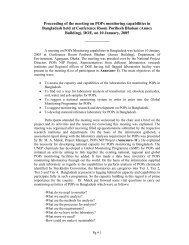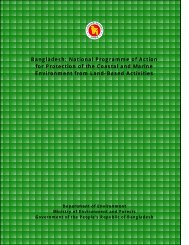Draft CMP HH - the Department of Environment
Draft CMP HH - the Department of Environment
Draft CMP HH - the Department of Environment
Create successful ePaper yourself
Turn your PDF publications into a flip-book with our unique Google optimized e-Paper software.
Coastal and Wetland Biodiversity Management Project BGD/99/G31<br />
Hakaluki Haor <strong>Draft</strong> Conservation Management Plan<br />
� Different part <strong>of</strong> each plant used<br />
(fruit, flower, seed, stem, leaf, bark,<br />
root etc.)<br />
� Way in which <strong>the</strong> plant is processed<br />
and stored<br />
� Cost and popularity <strong>of</strong> <strong>the</strong> plant<br />
� Plant availability and abundance in<br />
<strong>the</strong> market including season<br />
� Number <strong>of</strong> groups involved in<br />
making <strong>the</strong> medicinal plant available<br />
in <strong>the</strong> market<br />
� Number and status <strong>of</strong> <strong>the</strong> medicinal plant<br />
users (income, education, age, sex)<br />
� Number <strong>of</strong> ayurvedic and o<strong>the</strong>r doctors<br />
using medicinal plant from <strong>the</strong> Haor<br />
� Number <strong>of</strong> people selling medicinal plants<br />
in local markets<br />
� Number <strong>of</strong> people growing medicinal<br />
plants<br />
� Number <strong>of</strong> people harvesting/ collecting<br />
medicinal plants<br />
� Interest by pharmaceutical companies<br />
• Collect ecological information on all <strong>the</strong> medicinal plants <strong>of</strong> Hakaluki Haor including:<br />
� Area <strong>of</strong> <strong>the</strong> ECA in which <strong>the</strong> plant can be found<br />
� The status <strong>of</strong> each plant in terms <strong>of</strong> whe<strong>the</strong>r it is abundant, rare, threatened or endangered<br />
� Rate <strong>of</strong> growth<br />
� Growth conditions including preferred soil type, water tolerance, sunlight tolerance,<br />
whe<strong>the</strong>r it is an annual or perennial<br />
• Develop species recovery plans for endangered medicinal plant species<br />
• Raise awareness among <strong>the</strong> local community about <strong>the</strong> ecological and socio-economic<br />
significance <strong>of</strong> medicinal plants and <strong>the</strong> dangers <strong>of</strong> over-harvesting<br />
• Work with local communities to help protect and restore wild medicinal plant populations and<br />
communities within <strong>the</strong> ECA<br />
• Identify which medicinal plants have <strong>the</strong> potential to be more effectively included in <strong>the</strong> home<br />
garden as a cash crop and which can <strong>the</strong>refore be used to generated additional income for poorer<br />
families<br />
• In collaboration with local communities introduce appropriate medicinal plants into homestead<br />
gardens and provide support in finding market for <strong>the</strong> sale <strong>of</strong> <strong>the</strong> plant as needed<br />
• Provide support in processing <strong>of</strong> medicinal plants to help generate more substantial incomes for<br />
local communities<br />
Primary Outcome/ Output<br />
• Wild medicinal plants are protected<br />
• Numbers and variety <strong>of</strong> wild medicinal plants are increased<br />
• Threatened medicinal plant species are recovered<br />
Constraints<br />
• Preventing <strong>the</strong> over-harvesting <strong>of</strong> wild medicinal plants may prove to be a very difficult process<br />
• Ensuring <strong>the</strong> economic viability <strong>of</strong> medicinal plants grown in homestead gardens may be<br />
problematic especially in <strong>the</strong> short-term.<br />
Prepared by UNOPS Consultant Mr. Sulma Warne August/ September 2005 for Project BGD/99/G31 33





